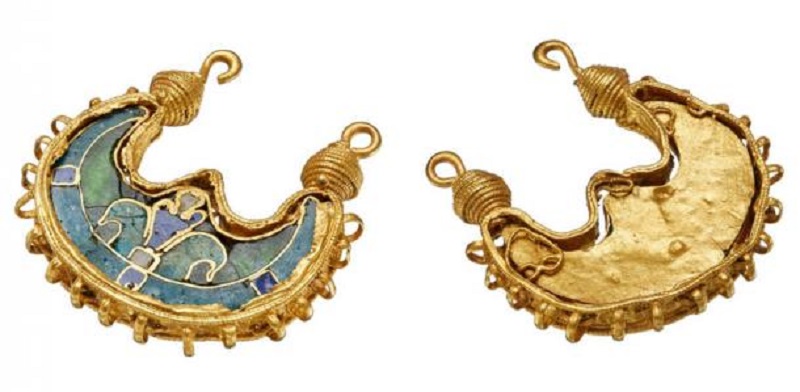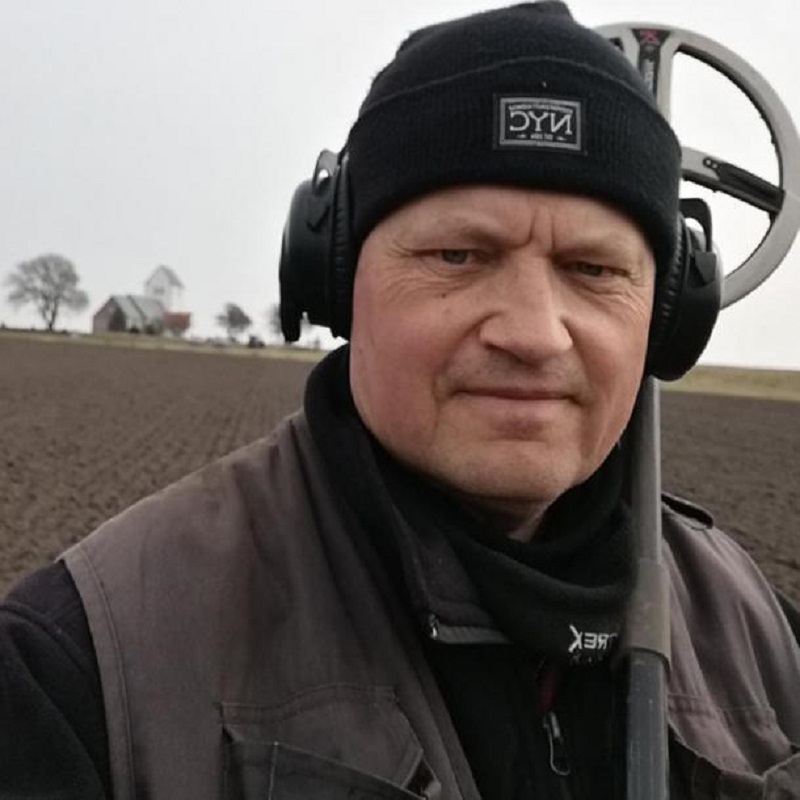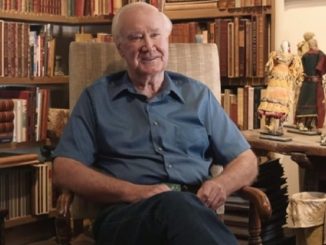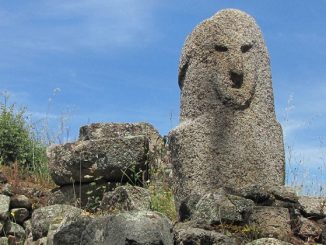The National Museum in Copenhagen announced on Sunday that Frants Fugl Vestergaard, 54, from Denmark, unearthed a rare gold earring while metal detecting in a field in West Jutland. Believed to be an 11th-century gift from the Emperor of Byzantium to a Viking chieftain, the earring is made around a crescent-shaped gold plate. Enameled in a gold thread frame, the gold earring is decorated with small gold balls and a gold chain. The pattern on the gold plate depicts two stylized birds on either side of the tree of life.
Frants Fugl Vestergaard unearthed a rare gold earring while metal detecting in a field in West Jutland. (National Museum)
Gold earrings as payment for bodyguards?
According to an article in Spiegel, National Museum experts are “confused” about how the gold earring got to where it was first dug up. This 1,000-year-old earring most likely came from the Middle East, and thus it represents “the first discovery of such an object in Scandinavia.” Museum researchers also said “this rare 1,000-year-old artifact could bring an archaeological breakthrough in understanding the Vikings and the Middle East.”
The gold earring is so rare that only 12 similar artifacts have been found anywhere. Museum expert Peter Pentz said the earring originated from Byzantium or Egypt and “may have been a gift from the emperor of Byzantium to a Viking leader”. However, it is being considered whether the Byzantium emperor may have given the earring to a Danish Viking, who perhaps served as a personal bodyguard.

Front and back of a rare gold earring discovered in West Jutland, Denmark. (National Museum)
A Viking dream discovery
In the mid-7th century, people in Denmark, Norway and Sweden began colonizing the British Isles. In the 8th century, they expanded their territory and plundered the coasts of Ireland, the Faroe Islands, Iceland, Greenland and Normandy, and expanded eastward along the Baltic coast. Known as the Varangians, they also invaded the Dnieper and Volga trade routes in Eastern Europe.
Although the Vikings brought home gold and silver coins, as well as other treasures raided from coastal villages, towns, and monasteries, TV Midwest reported that Pentz explained that “it was very rare to find jewels among their spoils.”
Not only is the earring’s origin a mystery but so is the story of how it came to be buried in West Jutland. Adding to the uncertainty, Pentz said there are no known Viking sites near the find site. For all these reasons, Frants Fugl Vestergaard, also from the Copenhagen Museum, concluded that the discovery “is a dream”.
Front and back images of a rare gold earring originating from the Middle East. (National Museum)
Middle Eastern treasures are otherworldly tools
A 2015 CNN article discussed the discovery of an ancient finger ring that was said to shed light on “the relationship between the Vikings and the Islamic world.” This ring was discovered in the town of Birka, on the island of Björkö, during the excavation of a 9th century Viking female grave in the late 19th century. Just 19 miles (30 km) from Stockholm, this ring is engraved with “AL_LLH” (Allah) in Arabic Kufic script. In an article published in the journal Scanning, researchers said it was “the only ring with Arabic inscription ever found at an archaeological site in Scandinavia.”
Evidence of Viking mercenary district found near Istanbul
Viking Age Jewelry: Revealing the Complex Cultural History of the Ancient Norse People
Like the recently discovered gold earring, the researchers concluded that the ring had “never been worn.” This suggests that Middle Eastern jewelry was one of the most valuable Viking treasures, and that the Viking Age elite who owned these items did not dare wear them, perhaps for fear of losing them.
Another thing that became clear, like the finger ring also discovered in a Viking grave, is that the leaders of this Scandinavian warrior class made sure they were buried with their treasures. this treasure. This suggests that the rare rings, like weapons, had supernatural powers and were considered important tools in the journey to the afterlife.




